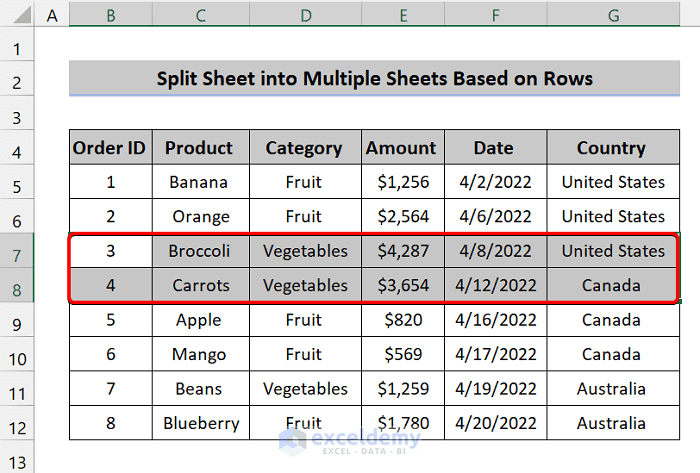5 Ways to Split Excel Sheets by Row Number

In today's data-driven world, managing large datasets in Excel can be both a necessity and a challenge. Often, when working with extensive Excel spreadsheets, you might find yourself needing to split these sheets into smaller, more manageable parts. This can help in improving performance, facilitating collaboration, or simply organizing data more efficiently. In this comprehensive guide, we will explore five effective methods to split Excel sheets by row number, ensuring you have the tools to manage your data with ease.
Method 1: Using Excel VBA Script

Visual Basic for Applications (VBA) in Excel offers a powerful way to automate repetitive tasks like splitting sheets:
- Step 1: Open your Excel workbook.
- Step 2: Press Alt + F11 to open the VBA editor.
- Step 3: Click “Insert” then “Module” to add a new module.
- Step 4: Copy and paste the following code into the module:
Sub SplitSheetByRows() Dim ws As Worksheet Dim newWs As Worksheet Dim startRow As Long Dim endRow As Long Dim rowIncrement As Long Dim sheetCounter As IntegerSet ws = ThisWorkbook.Sheets("Sheet1") rowIncrement = 1000 sheetCounter = 1 For startRow = 1 To ws.UsedRange.Rows.Count Step rowIncrement endRow = startRow + rowIncrement - 1 If endRow > ws.UsedRange.Rows.Count Then endRow = ws.UsedRange.Rows.Count ws.Rows(startRow & ":" & endRow).Copy Set newWs = ThisWorkbook.Sheets.Add newWs.Name = "Split" & sheetCounter newWs.Paste sheetCounter = sheetCounter + 1 Next startRow
End Sub
⚠️ Note: Ensure you modify the `rowIncrement` variable in the code to determine how many rows each new sheet should contain.
Method 2: Manual Split Using Filter

For those who prefer a less technical approach, Excel’s built-in filter tool can be manually used:
- Step 1: Open the workbook with your data.
- Step 2: Select the entire dataset.
- Step 3: Use the filter by clicking on the Data tab and then selecting ‘Filter’.
- Step 4: Filter data by a specific column value to show only the rows you want to move to a new sheet.
- Step 5: Cut these rows and paste them into a new sheet.
- Step 6: Repeat for each desired split.
This method is quite straightforward but can be time-consuming for large datasets.
Method 3: Using Advanced Filter

Excel’s Advanced Filter feature provides an automated way to split data:
- Step 1: Insert new columns next to the data you want to split.
- Step 2: Label these columns for each split segment (e.g., ‘Split_1’, ‘Split_2’).
- Step 3: Populate these columns with row numbers or criteria.
- Step 4: Go to Data > Advanced under ‘Sort & Filter’.
- Step 5: Set up the advanced filter to copy filtered rows to another location.
- Step 6: Use criteria ranges to copy data into new sheets.
Method 4: Power Query

Power Query, introduced in Excel 2010, allows for more complex data transformation:
- Step 1: Click on “Data” and then “From Table/Range” to open Power Query Editor.
- Step 2: Filter or group data as required.
- Step 3: Split the data by row number using custom functions or steps within Power Query.
- Step 4: Load each split segment into a new worksheet.
This method is excellent for recurring data splits or when dealing with large datasets with complex transformations.
Method 5: External Tools

Sometimes, native Excel tools may not meet all requirements:
- Option 1: Use third-party software like ‘Split Excel Sheets’ to automate splitting by row number or other criteria.
- Option 2: Consider programming tools like Python with libraries like openpyxl or pandas for custom splitting solutions.
Choosing an external tool can be useful when needing more advanced features or automating complex tasks beyond Excel's capabilities.
Final Thoughts

Splitting Excel sheets by row number offers various advantages from easier data handling to improved performance. Whether you’re automating processes through VBA or manually using filters, these methods cater to different levels of technical expertise and specific needs. Each method presents unique benefits, so selecting the right approach depends on the complexity of your data, your familiarity with Excel’s features, and how frequently you need to split sheets.
What is the benefit of splitting Excel sheets?

+
Splitting Excel sheets helps in managing large datasets more efficiently, improving workbook performance, and facilitating easier collaboration among team members.
Can I split sheets based on criteria other than row numbers?

+
Yes, you can split sheets based on various criteria like unique values in columns, dates, or custom rules through VBA, filters, or Power Query.
Is it possible to automate splitting Excel sheets?

+
Yes, methods like VBA scripts or using external tools can automate the process of splitting sheets, saving time and effort for recurring tasks.
How can I merge sheets back after splitting?

+
To merge sheets, you can copy and paste data from each split sheet into a single sheet, or use VBA or Power Query to consolidate data automatically.
Can I split a sheet without opening Excel?

+
Yes, using external tools or writing scripts in languages like Python allows for splitting Excel files without opening Excel, especially useful for batch processing.



